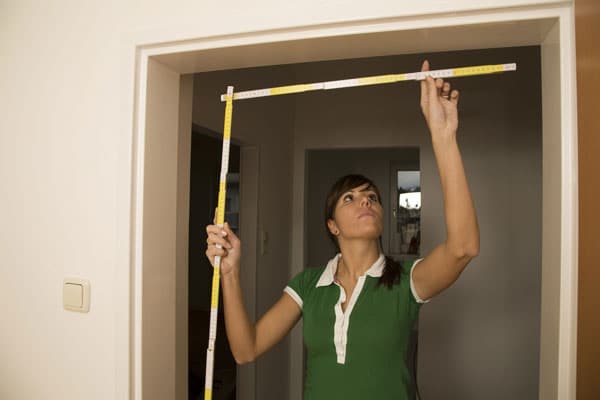One of the major disadvantages of moving by yourself, as opposed to hiring professional packers and movers, is when you do decide to move some of your large furniture with you. The problem, of course, usually arises on the day of the move when you have to physically move the big and heavy furniture items out of your home and load them onto the vehicle waiting outside.
The job of moving furniture by yourself should never be underestimated simply because your decision to handle the bulky units without professional assistance can lead to a serious Moving day issue.
What are your reasonable options if your big couch won’t fit through a door on its way out? And what if your dining room table is just too large to go through the kitchen door?
The thing is that beds, couches, dressers, tables, and desks can prove to be just too big to fit through small doorways and narrow hallways. And if that ever happens to you on Moving day, then, instead of getting angry, frustrated, and desperate by the mishap, you should be ready for the possibility and look for practical ways to solve the dimensional puzzle.
Follow these 7 steps if your furniture won’t fit through the door on Moving day.
Measure up the furniture and doorways
The very first thing you should do when you’re about to move some of your bulky furniture is to take accurate measurements of the furniture pieces and the doorways they are about to go through, and then compare the results.
This is the initial logical step that will tell you if you are likely to have a problem taking your furniture outside, and if yes, how serious that problem will be. So, make the required measurements using your trusted measuring tape.
- Furniture. Measure the height (H), diagonal height (DH), width (W), depth (D), and diagonal depth (DD) of the large furniture units that you suspect of not being able to fit through the door or hallway.
- Doorway. Measure the height and width of each door, hallway, or elevator along the intended exit path.
When done, compare the completed measurements to see whether you’ll have any difficulties getting your couch, or table, or dresser out of the place as it is. If the numbers spell out bad news for you, proceed with the steps below to solve the issue.
What to Do With Furniture When Moving
Find enough helpers
Your decision not to call up furniture movers to get the job done quickly and safely means only one thing – you’re going to have to ask reliable friends to help you get those big furniture pieces out of your home.
You can’t handle the task entirely on your own – even trained professionals work in teams. Therefore, you should do the sensible thing and secure enough manpower on Moving day to prevent any types of accidents – either property damage or personal injuries, or sometimes even both.
In most cases, you’re going to need at least two helpers to be by your side and assist you at all times. Make sure you reach out to your pals early enough so that you don’t completely ruin their own plans for that day.
How to Get Friends to Help You Move
Disassemble partially your furniture
Unfortunately, the measurements have shown that your furniture won’t fit through the door. Now, once you have secured the help of at least 2 good friends, it’s time to move on to the next step – disassembling partially the problematic pieces with the purpose of getting them safely through the door and along the narrow corridor.
This is a highly logical step – by removing any detachable parts of the large furniture items, their main structures will become smaller in size and should be able to go through smaller openings without any difficulties whatsoever.
Use your common sense (or the assembly manual) to remove any furniture parts that can be removed safely – the ones that will reduce the overall size of the unit as a whole. Such detachable elements are furniture legs (often the most problematic ones), arms, panels, doors, ornaments, and so on.
Remember to keep small fastening elements such as bolts, nuts, screws, etc. in a safe place – for example, inside a small plastic bag.
Should You Move Your Furniture or Buy New After the Move?
Try different exit angles
What to do if your furniture won’t fit through the door? The solution may be simpler than you think: try various exit angles and see if it works.
Before you even begin to move the furniture pieces, visualize the way they should be positioned in relation to the door so that they can clear the doorway safely. Longer pieces such as sofas will sometimes need to be taken out of the room in an upright position – that is, vertically – simply because doorways are always higher, not wider.
Some furniture items such as tables cannot clear the door unless they are turned at a specific angle and maneuvered slowly around the doorframe. Oftentimes, it just comes down to giving a bit of thought in order to solve the physics puzzle successfully.
Remember that when going through a narrow doorway or around a sharp corner, all your movements should be slow, precise, and well-calculated. One wrong step or abrupt movement can easily lead to chipped walls, scraped furniture, or injured fingers or toes.
Attempt to squeeze your soft furniture through the door
What to do if your sofa won’t fit through the door?
When you’re moving soft furniture such as a couch, sometimes the only thing you need to do is to squeeze it through the door. The good news is that those types of furniture have soft sides that can be compressed slightly without any damage whatsoever.
So, when you only need a few extra inches of space, then you should try squeezing the upholstered part of the furniture through the doorway. But before you try it, wrap the furniture item in stretch wrap as additional protection.
Also, be careful not to injure any of the fingers on your hand during the furniture-squeezing stage since there won’t be any extra place for your hands during the maneuver. To stay on the safe side, wear thick work gloves to protect your hands during the furniture-moving task.
Remove the door temporarily
Desperate times call for desperate measures.
Even after following the steps above, you may still get stuck in a doorway with a large piece of furniture. What if you only need a few more inches of free space to get a furniture item safely out of the door? Where do you find those couple of extra inches?
The answer might surprise you but it’s a well-known hack to fit larger furniture through a doorway without any damage: removing the door by taking it off its hinges. Of course, this is only a temporary solution but that’s all you need anyway.
So, together with a reliable helper, push the door up slightly until you release it from its hinges, then place it out of the way until the furniture item is safely through. Then, attach carefully the door back to its hinges as it was before.
Caution: Attempt this unusual solution only if you’re 100% sure that you can complete the step safely.
Hire experienced furniture movers
Your decision to move large furniture to the new home is brave, but making up your mind to do it without professional assistance is even braver. And much riskier too.
The major problem when moving by yourself is that you’re not likely to have the necessary experience and required equipment to move bulky furniture items. And this is exactly why you should seriously consider hiring experienced furniture movers who know exactly what it takes to move furniture in the safest way possible.
Get a free quote from Great Nation Moving or call us at (800) 403-7552. You can rest assured that your prized furniture will be in good hands.










